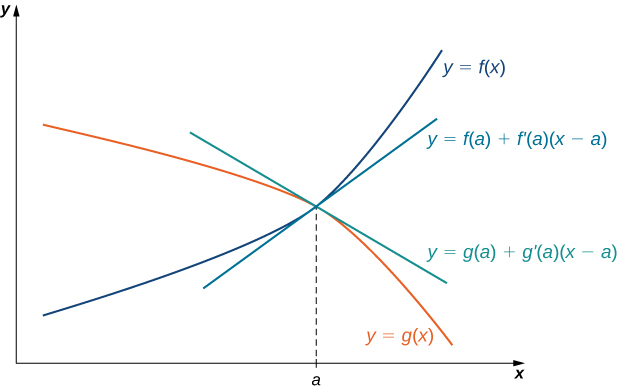Learning Outcomes
- Recognize when to apply L’Hôpital’s rule
Applying L’Hôpital’s Rule
L’Hôpital’s rule can be used to evaluate limits involving the quotient of two functions. Consider
If [latex]\underset{x\to a}{\lim}f(x)=L_1[/latex] and [latex]\underset{x\to a}{\lim}g(x)=L_2 \ne 0[/latex], then
However, what happens if [latex]\underset{x\to a}{\lim}f(x)=0[/latex] and [latex]\underset{x\to a}{\lim}g(x)=0[/latex]? We call this one of the indeterminate forms, of type [latex]\frac{0}{0}[/latex]. This is considered an indeterminate form because we cannot determine the exact behavior of [latex]\frac{f(x)}{g(x)}[/latex] as [latex]x\to a[/latex] without further analysis. We have seen examples of this earlier in the text. For example, consider
For the first of these examples, we can evaluate the limit by factoring the numerator and writing
For [latex]\underset{x\to 0}{\lim}\frac{\sin x}{x}[/latex] we were able to show, using a geometric argument, that
Here we use a different technique for evaluating limits such as these. Not only does this technique provide an easier way to evaluate these limits, but also, and more important, it provides us with a way to evaluate many other limits that we could not calculate previously.
The idea behind L’Hôpital’s rule can be explained using local linear approximations. Consider two differentiable functions [latex]f[/latex] and [latex]g[/latex] such that [latex]\underset{x\to a}{\lim}f(x)=0=\underset{x\to a}{\lim}g(x)[/latex] and such that [latex]g^{\prime}(a)\ne 0[/latex] For [latex]x[/latex] near [latex]a[/latex], we can write
and
Therefore,

Figure 1. If [latex]\underset{x\to a}{\lim}f(x)=\underset{x\to a}{\lim}g(x)[/latex], then the ratio [latex]f(x)/g(x)[/latex] is approximately equal to the ratio of their linear approximations near [latex]a[/latex].
Since [latex]f[/latex] is differentiable at [latex]a[/latex], then [latex]f[/latex] is continuous at [latex]a[/latex], and therefore [latex]f(a)=\underset{x\to a}{\lim}f(x)=0[/latex]. Similarly, [latex]g(a)=\underset{x\to a}{\lim}g(x)=0[/latex]. If we also assume that [latex]f^{\prime}[/latex] and [latex]g^{\prime}[/latex] are continuous at [latex]x=a[/latex], then [latex]f^{\prime}(a)=\underset{x\to a}{\lim}f^{\prime}(x)[/latex] and [latex]g^{\prime}(a)=\underset{x\to a}{\lim}g^{\prime}(x)[/latex]. Using these ideas, we conclude that
Note that the assumption that [latex]f^{\prime}[/latex] and [latex]g^{\prime}[/latex] are continuous at [latex]a[/latex] and [latex]g^{\prime}(a)\ne 0[/latex] can be loosened. We state L’Hôpital’s rule formally for the indeterminate form [latex]\frac{0}{0}[/latex]. Also note that the notation [latex]\frac{0}{0}[/latex] does not mean we are actually dividing zero by zero. Rather, we are using the notation [latex]\frac{0}{0}[/latex] to represent a quotient of limits, each of which is zero.
L’Hôpital’s Rule (0/0 Case)
Suppose [latex]f[/latex] and [latex]g[/latex] are differentiable functions over an open interval containing [latex]a[/latex], except possibly at [latex]a[/latex]. If [latex]\underset{x\to a}{\lim}f(x)=0[/latex] and [latex]\underset{x\to a}{\lim}g(x)=0[/latex], then
assuming the limit on the right exists or is [latex]\infty [/latex] or [latex]−\infty[/latex]. This result also holds if we are considering one-sided limits, or if [latex]a=\infty[/latex] or [latex]-\infty[/latex].
Proof
We provide a proof of this theorem in the special case when [latex]f, \, g, \, f^{\prime}[/latex], and [latex]g^{\prime}[/latex] are all continuous over an open interval containing [latex]a[/latex]. In that case, since [latex]\underset{x\to a}{\lim}f(x)=0=\underset{x\to a}{\lim}g(x)[/latex] and [latex]f[/latex] and [latex]g[/latex] are continuous at [latex]a[/latex], it follows that [latex]f(a)=0=g(a)[/latex]. Therefore,
Note that L’Hôpital’s rule states we can calculate the limit of a quotient [latex]\frac{f}{g}[/latex] by considering the limit of the quotient of the derivatives [latex]\frac{f^{\prime}}{g^{\prime}}[/latex]. It is important to realize that we are not calculating the derivative of the quotient [latex]\frac{f}{g}[/latex].
[latex]_\blacksquare[/latex]
Example: Applying L’Hôpital’s Rule (0/0 Case)
Evaluate each of the following limits by applying L’Hôpital’s rule.
- [latex]\underset{x\to 0}{\lim}\dfrac{1- \cos x}{x}[/latex]
- [latex]\underset{x\to 1}{\lim}\dfrac{\sin (\pi x)}{\ln x}[/latex]
- [latex]\underset{x\to \infty }{\lim}\dfrac{e^{\frac{1}{x}}-1}{\frac{1}{x}}[/latex]
- [latex]\underset{x\to 0}{\lim}\dfrac{\sin x-x}{x^2}[/latex]
Watch the following video to see the worked solution to Example: Applying L’Hôpital’s Rule (0/0 Case).
Try It
Evaluate [latex]\underset{x\to 0}{\lim}\dfrac{x}{\tan x}[/latex].
We can also use L’Hôpital’s rule to evaluate limits of quotients [latex]\frac{f(x)}{g(x)}[/latex] in which [latex]f(x)\to \pm \infty [/latex] and [latex]g(x)\to \pm \infty[/latex]. Limits of this form are classified as indeterminate forms of type [latex]\infty / \infty[/latex]. Again, note that we are not actually dividing [latex]\infty[/latex] by [latex]\infty[/latex]. Since [latex]\infty[/latex] is not a real number, that is impossible; rather, [latex]\infty / \infty[/latex] is used to represent a quotient of limits, each of which is [latex]\infty[/latex] or [latex]−\infty[/latex].
L’Hôpital’s Rule ([latex]\infty / \infty[/latex] Case)
Suppose [latex]f[/latex] and [latex]g[/latex] are differentiable functions over an open interval containing [latex]a[/latex], except possibly at [latex]a[/latex]. Suppose [latex]\underset{x\to a}{\lim}f(x)=\infty[/latex] (or [latex]−\infty[/latex]) and [latex]\underset{x\to a}{\lim}g(x)=\infty[/latex] (or [latex]−\infty[/latex]). Then,
assuming the limit on the right exists or is [latex]\infty[/latex] or [latex]−\infty[/latex]. This result also holds if the limit is infinite, if [latex]a=\infty[/latex] or [latex]−\infty[/latex], or the limit is one-sided.
Example: Applying L’Hôpital’s Rule ([latex]\infty /\infty[/latex] Case)
Evaluate each of the following limits by applying L’Hôpital’s rule.
- [latex]\underset{x\to \infty }{\lim}\dfrac{3x+5}{2x+1}[/latex]
- [latex]\underset{x\to 0^+}{\lim}\dfrac{\ln x}{\cot x}[/latex]
Try It
Evaluate [latex]\underset{x\to \infty }{\lim}\dfrac{\ln x}{5x}[/latex]
As mentioned, L’Hôpital’s rule is an extremely useful tool for evaluating limits. It is important to remember, however, that to apply L’Hôpital’s rule to a quotient [latex]\frac{f(x)}{g(x)}[/latex], it is essential that the limit of [latex]\frac{f(x)}{g(x)}[/latex] be of the form [latex]0/0[/latex] or [latex]\infty / \infty[/latex] Consider the following example.
Example: When L’Hôpital’s Rule Does Not Apply
Consider [latex]\underset{x\to 1}{\lim}\dfrac{x^2+5}{3x+4}[/latex]. Show that the limit cannot be evaluated by applying L’Hôpital’s rule.
Try It
Explain why we cannot apply L’Hôpital’s rule to evaluate [latex]\underset{x\to 0^+}{\lim}\dfrac{\cos x}{x}[/latex]. Evaluate [latex]\underset{x\to 0^+}{\lim}\dfrac{\cos x}{x}[/latex] by other means.
Watch the following video to see the worked solution to the above Try It.
